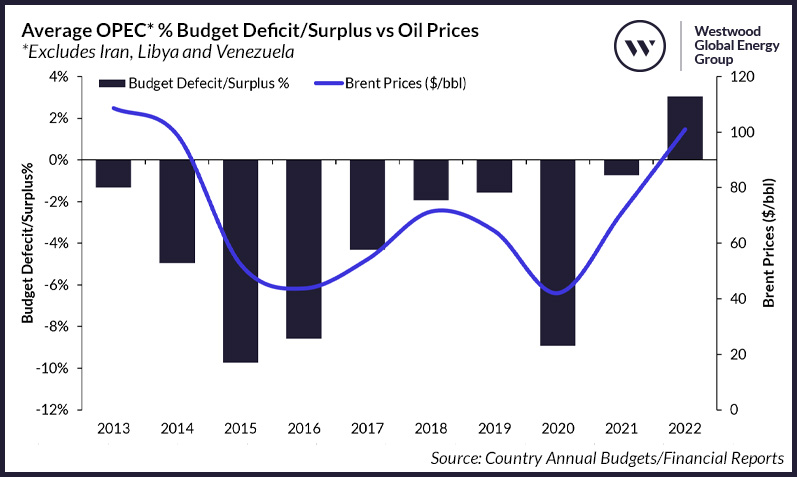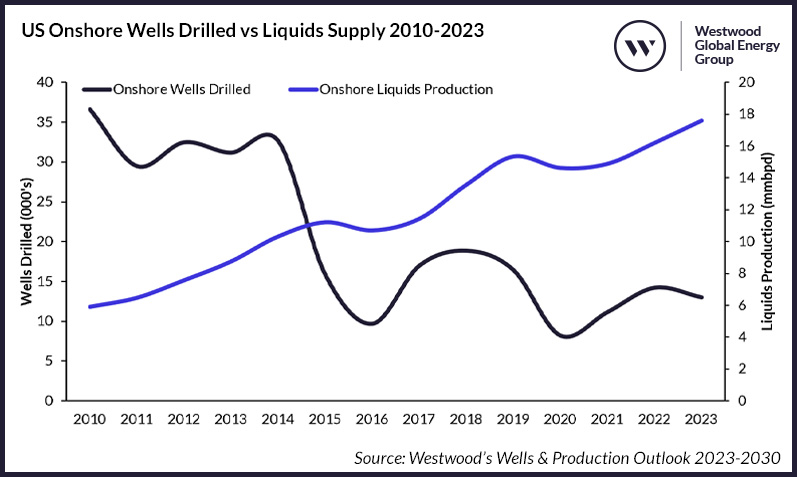The last few months have been significant for those in the OPEC+ group. Perhaps the most significant was Saudi Aramco’s announcement on 30 January that the Saudi Ministry of Energy had ordered the NOC to maintain its Maximum Sustainable Capacity at 12mmbpd rather than increase it to 13mmbpd by 2027 as previously planned. This news reflects concerns within the Saudi government over the necessity of a high-Capex 1mmbpd MSC addition, given supply growth elsewhere, especially from the Americas. As a result, in its March 2024 piece Aramco stated that total Capex over 2024-2028 would be reduced by US$40 billion due to project deferrals and reductions in infill drilling.
2024 YTD has seen Brent oil prices average $81.2/bbl, broadly in line with the 2023 average of $82.5/bbl. Despite significant global turmoil in 2023, the global oil supply/demand balance remains the primary driver for oil prices. In 2023, abundant non-OPEC+ supply, especially from the US, where growth of 8% was well above expectations at the start of the year, was countered by continued OPEC+ cuts. In addition, Saudi Arabia and Russia announced voluntary production cuts in 2023, pledging a combined voluntary output reduction of 1.5mmbpd. In 2024, this output reduction has been joined by six other OPEC members, leading to a total voluntary cut of 2.2mmbpd, which has now been extended through 2Q 2024.
The length and impact of these output restrictions in 2024 will largely depend on demand, an area that is growing increasingly partisan. After overestimating 2022 oil demand growth in December 2021, the IEA and OPEC underestimated the scale of demand growth in 2023 in December 2022. The IEA predicted 1.7mmbpd of demand growth on 2022, while OPEC predicted 2.25mmbpd. By December 2023, the IEA had revised its estimated oil demand growth to 2.3mmbpd, a 35% increase from its December 2022 forecast, with OPEC at 2.46mmbpd, an uplift of 9%. The variance between the two outlooks is even more stark for 2024, with the IEA’s January 2024 Oil Market Report forecasting demand growth of 1.24mmbpd in 2024, the third month in a row it has revised up its forecast, though it did reduce this to 1.2mmbpd in its February edition. Despite this, it remains 1mmbpd lower than OPEC’s expectations of 2.25mmbpd, as reported in its January 2024 Monthly Oil Market Report, a growth figure it has stuck to in its February 2024 edition.
Even in OPEC’s optimistic demand outlook, one thing is clear – OPEC+’s decision to continue its output reduction policy is likely to be the primary driver stopping oil supply from outweighing demand in 2024. The likelihood is that OPEC+ will stick to its output restriction policy to ensure that oil prices remain above Saudi’s fiscal breakeven point of $80/bbl. The economies of most members are still tied intrinsically to oil prices, including key Gulf States such as Saudi Arabia and Kuwait, who posted budget surplus’ in 2022 when oil prices averaged $100.3/bbl after nearly a decade of budget deficits.

Average OPEC* % Budget Deficit/Surplus vs Oil Prices
*Excludes Iran, Libya and Venezuela
Source: Country Annual Budgets/Financial Reports
The IMF estimated Saudi Arabia’s breakeven for 2024 to be $80/bbl and has many members of OPEC+ at or above this level, including Algeria ($145/bbl), Iraq ($98/bbl) and Kazakhstan ($99/bbl). As a result, unless there is a catastrophic drop in demand, OPEC+ is likely to continue with its current policies and has limited options to change course. The last time OPEC decided to produce unrestricted, which was a transparent attempt to squeeze out the US shale producers, the move backfired, causing budget deficits across the group. It also inadvertently forced shale drillers to come up with innovative solutions to reduce costs, including focusing on prime acreage, extending the life of wells by drilling longer laterals and performing more refracturing stages.
In 2023, the number of wells drilled in the lower 48 was estimated at 12,300, continuing a trend of lower wells drilled since the 2015 oil price crash and well below an average of 32,470 wells per annum between 2010 and 2014. Despite this decline in drilling, the US reached never before seen production levels, peaking at 13mbbpd of crude before the Covid-19 price crash (November 2019), before setting a new record of 13.3mmbpd in December 2023, the fifth month in a row of >13mmbpd production.

US Onshore Wells Drilled vs Liquids Supply 2010-2023
Source: Westwood’s Wells & Production Outlook 2023-2030
The short-cycle nature of barrels from US shale, a key driver for Exxon’s US$59.5 billion merger with Pioneer, means that they can be reactive to changes in pricing, as was seen during 2022 when the number of wells drilled increased 70% on 2020 levels. Taking the mid-point in demand between the IEA and OPEC, Westwood estimates that demand outstripped supply by 600kbpd in 2023. For 2024, this is expected to shrink to 0.1kbpd, despite OPEC+’s actions, as continued quick barrels from the US are joined by structural increases in supply from countries such as Brazil and Guyana. In total, Westwood expects to see an additional 1.2mmbpd of liquids supply coming into the market from non-OPEC sources in 2024, undercutting the actions of OPEC+ to reduce production.
Beyond 2024, the picture is more complex, as the growth rate in oil demand will underpin the actions of OPEC+ and non-OPEC member countries. Westwood anticipates significant drilling activity of over 38,500 wells per year to translate into an additional 4mmbpd from non-OPEC sources (including Brazil), with output declines in many countries outweighed by production additions elsewhere.

Non-OPEC+ Wells Drilled vs Liquids Supply 2023-2030
Source: Westwood’s Wells & Production Outlook 2023-2030
The majority of this increase will be related to long-term structural barrel increases, such as the deepwater projects in Brazil and Guyana. These two countries alone have 2.6mmbpd of new FPSO oil capacity already sanctioned, including five FPSOs at Petrobras’ Buzios development and two FPSOs at ExxonMobil’s Stabroek block offshore Guyana. The global picture indicates a total of 8mmbpd of additional FPS liquids capacity is expected by 2030, of which 4.2mmbpd are already sanctioned. Allied to this are new onshore drilling campaigns in countries such as Uganda, continued strong levels of development drilling in Canada and the US, and fixed platform additions in Qatar.
OPEC members also represent a major supply influx, given the significant investment many of them are making. Unlike Saudi Arabia, countries such as the UAE are moving forward with expansion plans and should hit their target of 5mmbpd by 2027. Even countries likely to struggle to hit their targets, such as Iraq and Nigeria, are expected to see an uplift in production given projects sanctioned or due to be sanctioned.
Saudi Arabia is not excluded from this either, despite the delay of its plan to reach 13mmbpd MSC by 2027, which has seen planned output increases at Manifa and Safaniya deferred. The outlook for Saudi Arabia also points to a major supply increase – especially compared to liquids production of 11mmbpd recorded in 2023, with crude production of just 9.6mmbpd – well below its structural capacity potential. Major new fixed platform installation campaigns at fields such as Abu Safa and Zuluf are expected to continue, despite the announcement, while a new onshore drilling rig construction campaign is underway to help boost onshore activity levels. Non-crude liquids will see a major boost due to the start-up of onshore activity. The Jafurah project alone is anticipated to add 625kbpd of condensate and NGLs by 2030. At the same time, assuming the output cuts come to an end, crude production will increase.
Overall, the picture for 2024 appears complex, with much of OPEC+’s production restriction efforts dependent on demand, given the flood of supply coming from non-OPEC+ sources. Beyond 2024, what is abundantly clear is that supply is in no danger of a shortfall. As a result, demand is likely to determine the trajectory of the oil industry over the next few years, with OPEC+ likely to continue output restrictions to maintain pricing at least above $70/bbl if required. Saudi Arabia’s decision not to pursue 13mmbpd of production means that the market is likely to be more delicately poised than previously expected. Despite this, the additional capacity increases expected in Latin America, combined with quick barrels from the US, mean that any supply shortfall is unlikely to last long.
Ben Wilby, Senior Analyst – Onshore Energy Services
[email protected]
Data is derived from Westwood’s Wells & Production Outlook 2023-2030, which is a series of four regional reports covering onshore and offshore drilling and production outlooks for Africa & Europe, the Americas, Asia Pacific and the Middle East. Published bi-annually, they are available to purchase individually or as a bundle.




